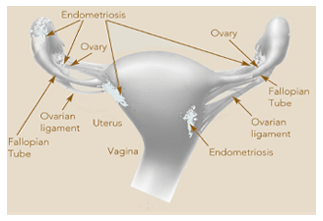Endometriosis
Jump to navigation
Jump to search
Endometriosis, a persisting (chronic) non-cancerous, estrogen-dependent disease, sometimes having an hereditary component, affecting up to 10% of women of reproductive age in the U.S., causes pain in the pelvis during the menstrual period and during sexual intercourse due to inflammatory swelling and bleeding of tissue resembling that lining the uterus (viz., endometrial tissue) abnormally implanted and growing as nodules on various areas of the pelvis and onthe ovaries, often accompanied by infertility.[1] [2] [3] [4] [5]
References
- ↑ Bulun SE. (2009) Endometriosis. Mechanisms of Disease Review Article. N Engl J Med 360:268-79.
- Extract from First Paragraph: Endometriosis is an estrogen-dependent inflammatory disease that affects 5 to 10% of women of reproductive age in the United States. Its defining feature is the presence of endometrium-like tissue in sites outside the uterine cavity, primarily on the pelvic peritoneum and ovaries. The main clinical features are chronic pelvic pain, pain during intercourse, and infertility. Endometriosis can be the result of diverse anatomical or biochemical aberrations of uterine function. For example, endometriosis commonly develops in young women with vaginal obstruction of outflow, possibly because of large quantities of backwashed menstrual tissue that has become implanted on pelvic organs...
- ↑ Dan Lebovic (Lead Editor). Endometriosis. Medpedia. Last Accessed: 28-Nov-2010.
- ↑ Giudice LC, Kao LC. Endometriosis. Lancet 2004;364:1789-99.
- From Abstract: Endometriosis is an oestrogen-dependent disorder that can result in substantial morbidity, including pelvic pain, multiple operations, and infertility. New findings on the genetics, the possible roles of the environment and the immune system, and intrinsic abnormalities in the endometrium of affected women and secreted products of endometriotic lesions have given insight into the pathogenesis of this disorder and serve as the background for new treatments for disease-associated pain and infertility. Affected women are at higher risk than the general female population of developing ovarian cancer, and they also may be at increased risk of breast and other cancers as well as autoimmune and atopic disorders.
- ↑ "Endometriosis In-Depth. Discover Health. Last Accessed: 28-Nov-2010
- ↑ Endometriosis. National Institutes of Health, Eunice Kennedy Shriver, National Institute of Child Health & Human Development, Last Update: 03/30/2010. Last Accessed: 28-Nov-2010.
- Contains links to site sections entitled: What is endometriosis? | In what places, outside of the uterus, do areas of endometriosis grow? | What are the symptoms of endometriosis? | Who gets endometriosis? | Does having endometriosis mean I’ll be infertile or unable to have children? | What causes endometriosis? | How do I know that I have endometriosis? | Why does having endometriosis cause pain? | Is there a cure for endometriosis? | Are there treatments for endometriosis? | What are the hormone treatments for endometriosis pain? | What are the surgical treatments for endometriosis pain? | What are the treatments for infertility related to endometriosis? | Is endometriosis the same as endometrial cancer? | Does endometriosis lead to cancer? | Does endometriosis ever go away? | What research is being done to learn more about endometriosis? | Where can I go for more information about endometriosis?
